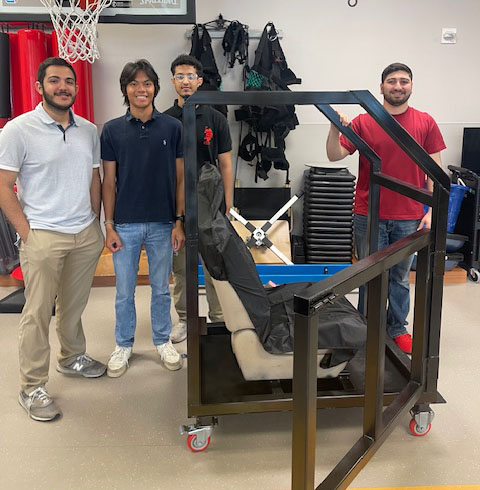by Hannah Buckelew
The UAB Department of Biomedical Engineering (BME) is known for routinely tackling daunting health problems head-on and has been doing so for nearly 45 years. When Children’s of Alabama reached out to the department with a need for a better way to assist in vehicle transfers, it is no surprise that UAB undergraduate students decided to fulfill this need for their senior design project.
“We chose this project because we found it meaningful, but not only that, we were confident that we could complete it and make a real impact,” says Mason Takvorian, team member.
The projects are created as part of BME’s capstone senior design course, instructed by Alan Eberhardt, Ph.D. Students are required to present a solution to a clinical problem provided by a client and develop a functional prototype and plan for product commercialization. They must follow guidelines such as adhering to a $400 design budget.
“The idea was to create a rehabilitation assessment tool so Children’s could see how well people can leave the hospital and get home in a car,” says Eberhardt. “The device simulates the process of getting in and out of a vehicle, complete with adjustable seats.”
Students Al Hassan Al Amin, Ash Mousa, Joseph Sucgang, Mariam Hamki and Mason Takvorian worked closely with client Rhett Wheeler, Inpatient Physical Therapy Coordinator, at Children’s of Alabama. The team collaborated with Steven Thompson, Field Project Manager in the Design Lab, to develop the product itself.
“There are similar products like this on the market, but none that are affordable options,” says Takvorian.
The team established design constraints and limitations before gaining client approval. After extensive research for planning the device’s design, the team began to order material to craft the frame.
“We cut the base plates and welded the steel onto the base to construct the frame,” says Al Hassan. “We eventually welded the chair into the frame, followed by wheels, followed by doors. In all, the project is about four and a half feet tall with adjustable features- perfect for both children and young adult users.”
Just as the team suspected, they were able to fully complete the device design and deliver it to Children’s of Alabama for testing. The client gratefully accepted the device, stating they plan to use it frequently to gauge patient transfer abilities.
As for the team members’ future plans, it is safe to say these recent graduates will be impacting the world for good. Takvorian plans to study prosthetics at Tampa’s International Institute of Orthotics and Prosthetics, Hassan is applying to dental schools, Hamki is applying to medical schools and Sucgang and Ash will go into industry.
